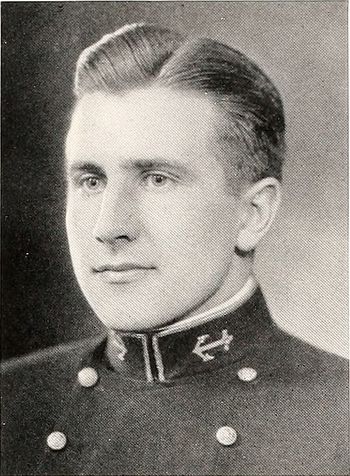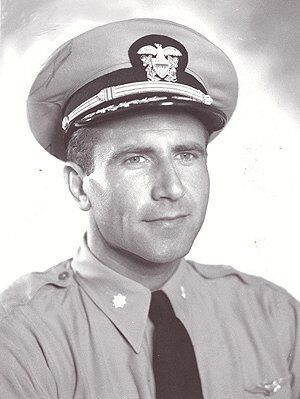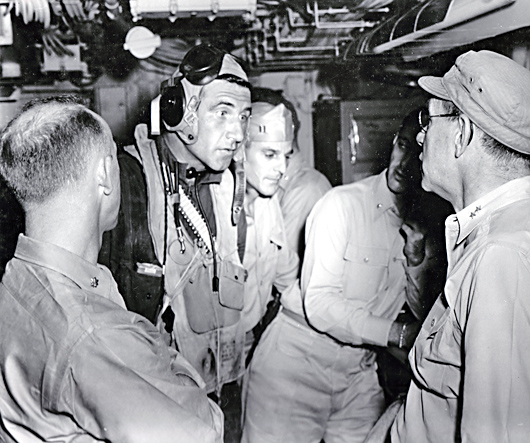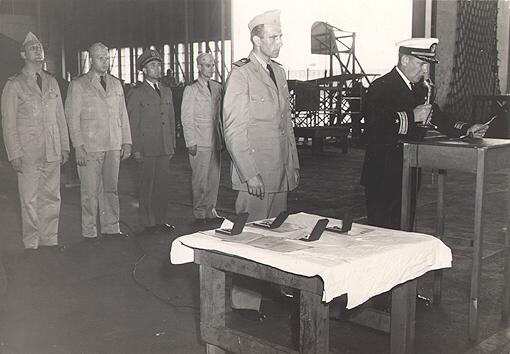GEORGE O. KLINSMANN, CDR, USN
George Klinsmann '33
Lucky Bag
From the 1933 Lucky Bag:
GEORGE OTTO KLINSMANN
Fargo, North Dakota
"Otto"
Fargo surrendered this stalwart son in the summer of 1918 when he went to Marion Institute for a year. He had no trouble with the "ac" departments' first big obstacle, nor has he had much since. While he didn't slight boning, he considered it worse to neglect going out for a sport. Football and crew were his pastimes Plebe Year—crew being the favorite. He still talks about life at Camp Ingram and the Poughkeepsie. Second Class Year, he went in for wrestling in a big way—so big that he made his letter. No sooner had he thrown his last man than he was out on the river pushing water past a shell.
You can't call Otto a "red mike," for he "dragged" after Plebe Year a couple of times. His array of sports seemed to keep him quite in training most of the time. He did manage, however, to frequent the hops and to make or renew the acquaintances of others' "drags." Thus his social contacts were not completely foregone.
Here is a real and true friend. Though obstinate at times, his congeniality and likable personality shadow his faults and gain him lasting friendships wherever he goes.
Football 4, 3; Wrestling 3, 2; Crew 4, 3, 2, 1; Lucky Bag Staff; Company Representative; N Club; G. P. O.

GEORGE OTTO KLINSMANN
Fargo, North Dakota
"Otto"
Fargo surrendered this stalwart son in the summer of 1918 when he went to Marion Institute for a year. He had no trouble with the "ac" departments' first big obstacle, nor has he had much since. While he didn't slight boning, he considered it worse to neglect going out for a sport. Football and crew were his pastimes Plebe Year—crew being the favorite. He still talks about life at Camp Ingram and the Poughkeepsie. Second Class Year, he went in for wrestling in a big way—so big that he made his letter. No sooner had he thrown his last man than he was out on the river pushing water past a shell.
You can't call Otto a "red mike," for he "dragged" after Plebe Year a couple of times. His array of sports seemed to keep him quite in training most of the time. He did manage, however, to frequent the hops and to make or renew the acquaintances of others' "drags." Thus his social contacts were not completely foregone.
Here is a real and true friend. Though obstinate at times, his congeniality and likable personality shadow his faults and gain him lasting friendships wherever he goes.
Football 4, 3; Wrestling 3, 2; Crew 4, 3, 2, 1; Lucky Bag Staff; Company Representative; N Club; G. P. O.
Loss
George was killed in action on January 15, 1945 when his aircraft was shot down while leading a strike against Japanese targets in Takao Harbor, Formosa. He was commanding officer of Air Group (CAG) 4, operating from USS Essex (CV 9).
Other Information
From the 1953 edition of the book "Double Three Roundup," published by the class of 1933:
Otto spent his JO years in the MISSISSIPPI, becoming an aircraft gunnery observer in May 1935. He was ordered to Pensacola the next January and led the class through flight training.
He was designated a naval aviator on 26 February 1937, then ordered to VB-1-B at San Diego for a short time before reporting to Torpedo Squadron 2 (LEXINGTON), with whom he flew the next two years. Joining PatRon 18 in June 1939 he stayed with the Squadron under its new designations, PatRon 13 then PatRon 26, through the summer of 1940. His next assignment was Pensacola, then the air station at Miami, as a flight instructor in both cases.
In October 1942 Otto was ordered as CO of Scouting Squadron 42 aboard the RANGER, becoming CO of VB-4 in the same ship some ten months later. The RANGER participated in several active combat operations during that period, on one of which Otto was forced to ditch in frigid North Atlantic waters, being rescued some minutes beyond what was then reckoned as the survival time for that area. He became CO of Air Group Four in March 1944, taking it to the Pacific area. While leading the attack during the China-Formosa strikes on 15 January 1945, he and his airplane were lost before aid could be rendered by one of the picket vessels near which he landed. George Otto was considered to be one of the finest naval aviators and officers of his time; his passing was a great loss to his many friends.
Otto and Beverly Moore of Bennettsville, South Carolina, were married on 3 February 1941 in Fort Lauderdale, Florida. They had no children, and Beverly is now Mrs. John Muckerman of 4165 Alton Road, Miami Beach, Florida. Otto was awarded the Distinguished Flying Cross, Legion of Merit, Bronze Star, Air Medal, and Purple Heart.
From Air Group 4:
It had been three days since the strike on Saigon. No further word was received about Don Henry or Shirley. Squadron members went ahead with the inventory of their gear and Ham was assigned the duty to notify the relatives back home.
The weather turned bad in the next several days with rumors of an impending typhoon. Nevertheless, on 15 January 1945, the Essex received orders to launch a strike group against prime shipping targets in Takao Harbor, Formosa.
Twelve Avengers, with an escort of nine fighters, were launched with instructions to rendezvous below the cloud ceiling of 800 feet and proceed to target.
Commander G. O. Klinsmann led the group, flying the lead Hellcat. All but two of the fighters were loaded with bombs or rockets. The other VF in Klinsmann's division were flown by Martin, White, and Maikowski. Lt Blackwell led the second fighter division, which included Olson, Garrigan, Hinrichs, and McBee.
After flying through very undesirable weather conditions, the attack group reached Takao Harbor, only to find it closed in by clouds. Cdr Klinsmann then ordered the flight to proceed to the Pescadores Islands, where shipping had been reported. Ample targets were found in Mako-Ko, and targets were assigned to VT and VF by divisions. The weather here was also very bad.
The Tactical Organization for Torpedo Four was:
Pilot Crew Hamrick, Lee L. (Ham) Trembley, R. A. Gardner, Keith Wilson, P. J. Ward, Jr., Felix E. Applegate, Don M. Hewett, J. E. Shuman, L. P. Newell, E. A. (Ted) Lace, W. J. Bissell, F. H. Cook, W. B. Souza, Will S. Sims, T. R. Cole, L. A. (Cozy) Shiverdecker, N. L. Trexler, B. R. (Trex) Aldrich, J. W. Gray, L. C. Green, H. R. Ruth, Robert F. (Bob) McConnell, C. L.
Montague, R. B.Bell, G. M. Pittman, R. R. Upon arrival at the Pescadores, the flight found two warships (a destroyer and its escort) and three or four AKs or AOs. The DE was anchored and the DD was underway. Antiaircraft fire was "most intense" from shore installations and from the ships, particularly the DD and DE.
"The low cloud cover compelled VT pilots to employ very shallow glides, greatly reducing the accuracy of the drops. Lt Hamrick scored with a hit directly amidships on the Fox Tare Baker. Ensign Gardner placed one bomb on the stern of the same ship. Lt (jg) Ruth hit the Fox Baker amidships with a 500 pounder. There were many near misses, none of which appeared to be damaging, on all four of the ships attacked. The DD appeared to be burning on departure, probably as a result of VF attack."
After Cdr Klinsmann assigned VT targets, he led his own division in a rocket and strafing attack, and sent Lt Blackwell's division against ground installations at the Naval Base at Mako.
"Commander Klinsmann picked the DD as a target for his division scoring two rocket hits himself just aft of amidships on the DD from reports of others on the flight. Lieutenant White fired his rockets at the largest of the AKs, a probable SB. Lieutenant White saw his rockets hit about 50 feet to port of the vessel. Ensign Hinricks [sic] aimed his half-tonner at another AK but missed. A small harbor craft was strafed vigorously by a single VF without obvious effect."
"Immediately after this attack, Commander Klinsmann's plane was seen covered with oil from an AA hit probably in the oil line. This necessitated immediate return to the ship without further observing results. Lieutenant Blackwell's division, which had been attacking shore installations at Mako, was ordered to escort the VT. Commander Klinsmann's division, plus Ensign Olson, started back toward base."
"Because of the clouds the flight soon lost sight of land. Lieutenant White, Lt (jg) Maikowski, and Ensign Olson broke off from the others and flew toward Formosa… to check their position against known land."
Due to low oil pressure from the AA damage to his Hellcat, Cdr Klinsmann decided to make a water landing near the two dispatched US picket destroyers, "…rather than depend on his plane flying the additional 50 miles over very rough seas." The remainder of the combat report states:
"…His wingman, at his request, went over the forced landing check off procedure and got a 'thumbs up' on each item. Both DDs were informed of the unpending [sic] water landing and were standing by to effect the rescue. The Commander made a perfect water landing, was observed to abandon and clear his plane before it sank. Lt (jg) Martin, the group commander's wingman, had experienced engine trouble on the return flight and as the two DDs had the Commander in sight, and the view of the Commander's apparent good condition and position for a quick rescue by either of the DDs the wingman departed for base upon receiving a wave of one hand from him indicating that the Commander was able to take care of himself from then on."
"One of the DDs reported having Commander Klinsmann in sight, successfully throwing him a life line with a life buoy ring attached, and as he was pulled alongside and about to be hoisted aboard he lost his grasp on the ring (the DD having just enough stern way on for steerage), floated clear of the bow and sank before the DD could position itself again. The DD reported that neither Commander Klinsmann's life jacket nor life raft were inflated."
There was great sadness aboard the Essex when the rest of Air Group Four heard about the loss of our friend and Commander. Otto had been with us since the early days on the Ranger. He was a good pilot; respected by the dive bombers because he first led their "Top Hat" squadron; supported by VT-4 because he knew how to bomb; and acknowledged by his fellow fighters in VF-4 because he readily adapted to the Hellcats and never hesitated to lead his group into the most intense action.
John Selka, who served as Otto's plane captain, stated, "He was a wonderful man, a great leader; a gentleman. He treated everyone, including enlisted men, like his own family." His Chief Yeoman, Don Anderson, added:
"I share the same feelings about George Otto Klinsmann. He was always thinking of his people, his pilots, his crewmen. I was his chief yeoman, and he was like a father figure to me. After the debriefing reports were checked by the ACI officers, I had the job of typing them and turning them over to Cdr Klinsmann. I was so busy typing reports for Otto that I rarely got ashore for R&R."
There was no panic about Otto's ditching. It was easy to see why he would not bother to inflate the rubber raft--besides it wasn't that easy to release and inflate. Also, to inflate the life jacket too soon could be cumbersome, so he probably thought that was not necessary in spite of the rough seas. There was one complicating factor--Otto carried extra gear that might have contributed to his drowning. Don Alexander stated:
"I'm not talking about one or two pounds! He had a couple of extra boxes of shells in his flight-suit pockets--and extra survival equipment. If he went down over land he wanted to be able to survive. This extra weight certainly would inhibit his ability to stay afloat."
Nevertheless, none of us could understand why the rescue destroyer did not send some seamen overboard to assist with the rescue. When I went down the next day, several men jumped into the rough seas to help me reach the lines dropped over the side. As the operations report states, Cdr Klinsmann's loss was "unexplainable… unwarranted."
From Air Group 4:
Douglas Dive Bomber BuNo 10744 was piloted by Lt Cdr George O. "Otto" Klinsmann, Skipper of VB-42 (later VB-4), the "Top Hatters." His crewman was Aviation Chief Radioman Elmer M. Rogers. The SBD went into the drink during night carrier operations on July 24, 1943. Three references are cited below:
"July 24, 1943--Left Newfoundland at 1215. F4F crashed barrier. One F4F busted wheels. SBD crashed overboard. Men OK." -- From the Journal of Signalman Ernest L. Crochet aboard the USS Ranger.
"Only a short time before the night training evolutions were to begin, Lt. Cdr George O. "Otto" Klinsmann, who had been commanding officer of VB-42 since 28 October 1942 had lectured his pilots on `safe techniques` for such operations. The Ranger turned into the wind, 11 minutes into the mid-watch, and 5 minutes later, Otto Klinsmann, in the cockpit of 42-B-1 (BuNo 10774) released his brakes and pushed the throttle forward.... Klinsmann`s plane crashed off the Ranger`s starboard bow. Fortunately, the Forrest picked up Klinsmann and Aviation Chief Radioman Elmer M Rogers, his radio-gunner, within eight minutes of their impromptu dip, and soon the carrier turned into the wind and resumed launching VB-42`s 12 SBDs." -- From USS RANGER: The Navy´s First Flattop from Keel to Mast by Robert J. Cressman.
"One night Otto Klinsmann, Skipper of Bombing 4, lectured to all the pilots in the Ready Room on safe techniques for night operations. He summed up by saying, `Keep cool. Don`t lose your orientation.` Because I was not scheduled on the night Otto gave the lecture, I went up to the bridge to watch the operations. Otto was in the take-off spot with his SBD. He revved up full throttle, received the take-off signal, and started down the flight deck. It was an unusually dark night with no visible horizon. About the time Otto popped his flaps the plane started bouncing off toward the starboard before it became airborne. It disappeared over the flight deck and plunged into the drink. A deckhand ran over to the catwalk and threw in a flare to mark the point for the trailing destroyer. We brought Lt. Cdr Klinsmann and his crewman back aboard the next morning. When we asked what happened he simply stated, `I lost my orientation`" -- Torpedo Squadron Four: A Cockpit View of World War II by Gerald W. Thomas.
Otto Klinsmann was a good pilot, a good skipper for VB-4, and eventually our Air Group Commander in the Pacific. Unfortunately, he was lost after an attack on a Japanese Destroyer in the Pescadores Islands. His F6F Hellcat was hit by enemy AA fire; he landed the disabled plane in the water but drowned before he could be rescued by a friendly destroyer.
Unable to find exact dates of when George took command of Bombing Squadron (VB) 42 (later re-designated Bombing Squadron (VB) 4) or Air Group Four. Also unable to find a concise summary of the actions he, his squadron, or his air group were involved in, though he is mentioned many times at the Air Group Four website and in the book Torpedo Squadron Four - A Cockpit View of World War II (Air Group 4 History).
His wife was listed as next of kin. He has a memory marker in South Carolina.
Photographs
Memorial Hall Error
George's last name is incorrectly spelled "Klinnsmann" on the killed in action panel in the front of Memorial Hall.
The "Register of Commissioned and Warrant Officers of the United States Navy and Marine Corps" was published annually from 1815 through at least the 1970s; it provided rank, command or station, and occasionally billet until the beginning of World War II when command/station was no longer included. Scanned copies were reviewed and data entered from the mid-1840s through 1922, when more-frequent Navy Directories were available.
The Navy Directory was a publication that provided information on the command, billet, and rank of every active and retired naval officer. Single editions have been found online from January 1915 and March 1918, and then from three to six editions per year from 1923 through 1940; the final edition is from April 1941.
The entries in both series of documents are sometimes cryptic and confusing. They are often inconsistent, even within an edition, with the name of commands; this is especially true for aviation squadrons in the 1920s and early 1930s.
Alumni listed at the same command may or may not have had significant interactions; they could have shared a stateroom or workspace, stood many hours of watch together, or, especially at the larger commands, they might not have known each other at all. The information provides the opportunity to draw connections that are otherwise invisible, though, and gives a fuller view of the professional experiences of these alumni in Memorial Hall.
July 1933
October 1933
April 1934
July 1934
October 1934
January 1935
April 1935
October 1935
ENS Frederick Purdy '33 (USS Mississippi)
ENS Walker Ethridge '34 (USS Mississippi)
ENS Philip Torrey, Jr. '34 (USS Mississippi)
ENS Manning Kimmel '35 (USS Mississippi)
ENS George Philip, Jr. '35 (USS Mississippi)
January 1936
ENS Walker Ethridge '34 (USS Mississippi)
ENS Philip Torrey, Jr. '34 (USS Mississippi)
ENS Manning Kimmel '35 (USS Mississippi)
ENS George Philip, Jr. '35 (USS Mississippi)
April 1936
LTjg John Duke '26
1LT Ernest Pollock '28
LTjg William Pennewill '29
LTjg Gilbert Carpenter '30
LTjg Lance Massey '30
LTjg William Sisko '31
LTjg Charles Mallory, Jr. '32
July 1936
LTjg John Duke '26
CAPT Ernest Pollock '28
LTjg William Pennewill '29
LTjg Gilbert Carpenter '30
LTjg Lance Massey '30
LTjg William Sisko '31
LTjg Charles Crommelin '31
January 1937
LT John Duke '26
CAPT Ernest Pollock '28
LTjg William Pennewill '29
LTjg Gilbert Carpenter '30
LTjg Lance Massey '30
LTjg William Sisko '31
1LT Harold Larson '31
LTjg Charles Crommelin '31
ENS Harold Von Weller '33
April 1937
September 1937
LT John Duke '26 (Fighting Squadron (VF) 2)
LTjg George Ottinger '32 (Bombing Squadron (VB) 2)
LTjg William Kane '33 (Fighting Squadron (VF) 2)
ENS John Eichmann '35 (USS Lexington)
ENS Thomas Edwards, Jr. '37 (USS Lexington)
January 1938
LT John Duke '26 (Fighting Squadron (VF) 2)
LTjg John Speer '32 (USS Lexington)
LTjg George Ottinger '32 (Bombing Squadron (VB) 2)
LTjg Thompson Guthrie, Jr. '34 (Scouting Squadron (VS) 2)
ENS Thomas Edwards, Jr. '37 (USS Lexington)
July 1938
LT Clair Miller '29 (USS Lexington)
LTjg Charles Crommelin '31 (Fighting Squadron (VF) 2)
LTjg John Speer '32 (USS Lexington)
LTjg Robert Goodgame, Jr. '32 (Scouting Squadron (VS) 2)
ENS Thomas Edwards, Jr. '37 (USS Lexington)
ENS Frank Case, Jr. '38 (USS Lexington)
ENS John Woodruff '38 (USS Lexington)
January 1939
LTjg Charles Crommelin '31 (Fighting Squadron (VF) 2)
LTjg John Speer '32 (USS Lexington)
LTjg Thompson Guthrie, Jr. '34 (Scouting Squadron (VS) 2)
ENS Frank Case, Jr. '38 (USS Lexington)
ENS John Woodruff '38 (USS Lexington)
October 1939
June 1940
November 1940
April 1941

The "category" links below lead to lists of related Honorees; use them to explore further the service and sacrifice of alumni in Memorial Hall.


